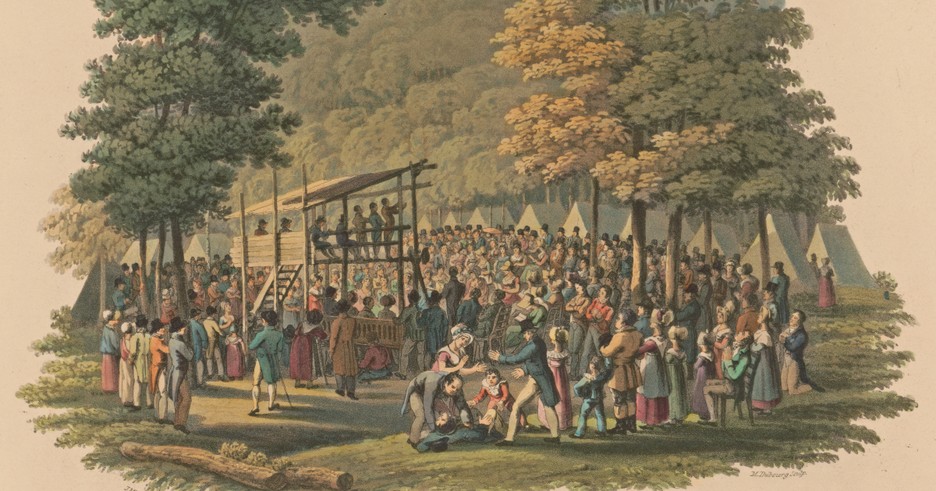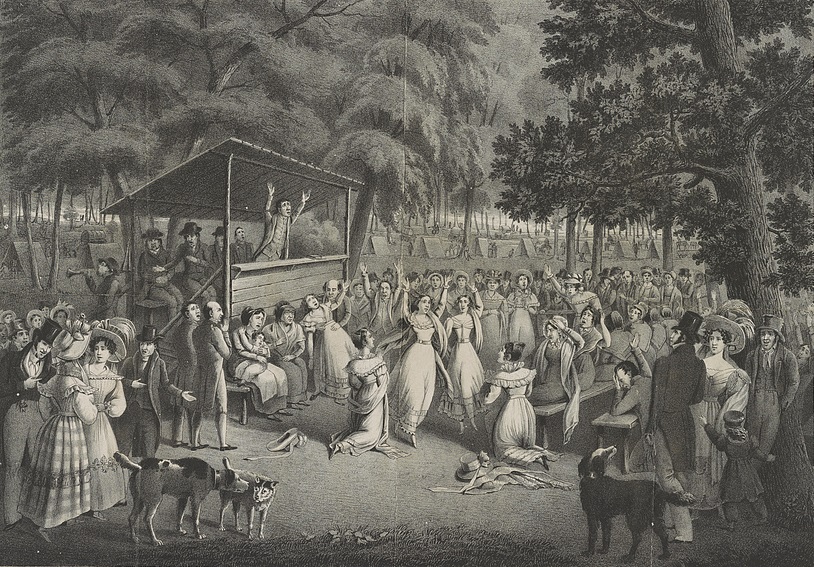
What was the Second Great Awakening?
To understand what the Second Great Awakening was, we need to go back to earlier revivals and the current social environment of the 1800s. During the first half of the 1800s, the population of the United States grew from five to thirty million, and the nation's boundary moved ever westward. Revivals became the primary means of Christianizing the growing and expanding population. These revivals at the beginning of the nineteenth century became known as the Second Great Awakening.
On the American frontier, camp meetings came to characterize revivals. The first camp meeting revival was in south-central Kentucky. At a meeting in June 1800, Presbyterian James McGready and two other pastors preached for three days; on the fourth day, two traveling Methodist ministers officiated and concluded with an emotional exhortation. Many physically collapsed at what they called the conviction of sin. People were convinced they were experiencing a visitation of the Holy Spirit, such as the early church had known at Pentecost.
Strange Manifestations

Pictured Above: Painting of Camp Meeting from the Second Great Awakening
Another meeting was called for July at the Gasper River Church to wait "for the Spirit to descend again." Some people came over one hundred miles to attend the meeting; they prepared to camp out in wagons, tents, and makeshift shelters until a revival came. When a great wave of emotional conversions occurred, the people were convinced this was of God.
In August 1801, Barton W. Stone led a revival in Cane Ridge, Kentucky, that became the most famous camp meeting. The meeting lasted a week, and 23,000 people came. The preaching was simple, lively, and persuasive, with preachers from different denominations sharing the platform. The common people were deeply affected, and, as at the Gasper River meeting, strong emotional responses were considered proofs of conversion. Often these produced strange physical manifestations - some people fainted and fell to the ground (were "slain in the spirit") or suffered uncontrollable shaking ("the jerks"). There was dancing, running and singing - all of which Stone said were manifestations of God's presence. The noise of the meetings was so great that some said: "the noise was like the roar of Niagara." Revival camp meetings swept through Kentucky, Tennessee, and many of the southern states.
Ecstasy or Anarchy?
The revivals in the east were much more subdued than those on the frontier; many of the eastern revivalists were highly critical of the emotional excesses of the Cane Ridge camp meeting. One Presbyterian minister said the anarchy of the camp meetings must have had some connections with the French Revolution!
Pictured below: A Tent Revival of the Second Great Awakening

The Revival at Yale
In the east, Yale University experienced a revival of Biblical Christianity under President Timothy Dwight, Jonathan Edwards' grandson. Christianity was almost nonexistent then at Yale, the campus church almost extinct. For four years, Dwight preached a series of weekly sermons on Christian belief; when he finished the series, he started over again. Finally, in 1801, after seven years of preaching, revival came to Yale. At least half of the student body was converted to Christianity under Dwight's Presidency. One college tutor wrote home to his mom, "Yale College is a little temple; prayer and praise seem to be the delight of the greater part of the students while those who are still unfeeling are awed with respectful silence."
Revival... from God or Man?
The Second Great Awakening had a tremendous effect on American society by spawning a large number of social reform movements. A great encourager of such reforms was the evangelist Charles G. Finney. Finney was to bring in new methods and a new attitude toward revival. Jonathan Edwards had viewed the 1735 revival in Northampton as "a very extraordinary dispensation of Providence" and a "surprising work of God." Charles Finney, however, believed that "a revival is not a miracle . . . It is a purely philosophic [i.e. scientific] result of the right use of the constituted means." In the series of revivals Finney held from 1824-1837 (during what some call the Third Awakening), Finney instituted a number of new measures which later evangelists would continue. These included the inquiry room for counseling seekers, the anxious or mourners' bench for those responding to the public invitation to Christ, preaching for an immediate decision, emotional prayers which addressed God in a very familiar, informal language, organized choirs and music, advertising and advanced preparation for the revival meeting.
Origin of Evangelistic Invitation
Finney believed that revival was not something sent down by God, but it could be brought about if the right means were used. A man was free to choose his spiritual destiny. Finney pressed for decisions. He was the first to have an "invitation" calling people to the front to make a public witness of their conversion.
Second Great Awakening Change and Results
Finney believed the gospel did not just get people saved, but it was also a means of cleaning up society. He and his followers worked to make the United States a Christian nation. Finney himself was a strong abolitionist and encouraged Christians to become involved in the antislavery movement. Christians became the leaders in many other social concerns, such as education, prison reform, temperance, Sabbath observance, and women's rights. The large numbers of Christian workers for social reform became so influential that the organizations they founded became known as the Benevolent Empire. The Second Great Awakening had a greater effect on society than any other revival in America.
Revival and mission interest |


_639003522088907085.jpg)